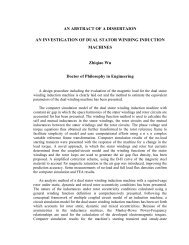CLIFFORD AND GRASSMANN HOPF ALGEBRAS VIA THE ...
CLIFFORD AND GRASSMANN HOPF ALGEBRAS VIA THE ...
CLIFFORD AND GRASSMANN HOPF ALGEBRAS VIA THE ...
You also want an ePaper? Increase the reach of your titles
YUMPU automatically turns print PDFs into web optimized ePapers that Google loves.
product ⋆ of endomorphisms according to Sweedler [21] as<br />
(f ⋆g)(x) =m ◦ (f ⊗ g) ◦ ∆(x)<br />
where ◦ is the composition of maps. The element x can be dropped safely. Remember<br />
that the antipode is the convolutive inverse of the identity morphism<br />
1V on V.<br />
In the following we will compute an antipode for the Graßmann Hopf algebra,<br />
for a twisted Graßmann Hopf algebra where only the product is deformed,<br />
and for the Clifford bi-convolution where both structure maps, product and<br />
coproduct, have been deformed. The last case is currently beyond the deformation<br />
theory, where only one structure map is deformed. We choose dimension 2<br />
for the generating space which gives 4 dimensional Graßmann and Clifford algebras.<br />
The output is suppressed in most steps since it is very long. In the first<br />
step, defining equations for the three antipodes are stored in eq_gr, eq_cl and<br />
eq_bc.<br />
> dim_V:=2:bas:=cbasis(dim_V):<br />
> B:=matrix(dim_V,dim_V,(i,j)->b[i,j]): #scalar product<br />
> BI:=matrix(dim_V,dim_V,(i,j)->c[i,j]): #coscalar product<br />
> make_BI_Id(): ## S:=matrix(2^dim_V,2^dim_V,(i,j)->s[i,j]): #antipode template<br />
> Sop:=proc(x) linop(x,S) end proc: #operator using S<br />
> X:=add(x[i]*bas[i],i=1..2^dim_V): #general element<br />
> eq_gr:=drop_t(&map(mapop(&gco(X),1,Sop),1,wedge)-gco_unit(&t(X),1)):<br />
> eq_cl:=drop_t(&map(mapop(&gco(X),1,Sop),1,cmul )-gco_unit(&t(X),1)):<br />
> eq_bc:=drop_t(&map(mapop(&cco(X),1,Sop),1,cmul )-gco_unit(&t(X),1)):<br />
In a second step we solve these equations using the BIGEBRA tangle solver<br />
tsolve1:<br />
> sol_gr:=tsolve1(clicollect(eq_gr),<br />
[seq(seq(s[i,j], i=1..2^dim_V),j=1..2^dim_V)],[seq(x[i],i=1..2^dim_V)]):<br />
> sol_cl:=tsolve1(clicollect(eq_cl),<br />
[seq(seq(s[i,j], i=1..2^dim_V),j=1..2^dim_V)],[seq(x[i],i=1..2^dim_V)]):<br />
> sol_bc:=tsolve1(clicollect(eq_bc),<br />
[seq(seq(s[i,j], i=1..2^dim_V),j=1..2^dim_V)],[seq(x[i],i=1..2^dim_V)]):<br />
Before we display these morphisms in a matrix form, we compute a normalization<br />
factor N for the antipode Sbc of the Clifford bi-convolution to simplify<br />
the output, which will be given as Sbc = NS ′ bc . Here the primed antipode S′ bc<br />
is the actual one and the unprimed one is the normalized one.<br />
> N:=linalg[det](linalg[diag](1$dim_V)- B &* BI):<br />
> S_GR:=subs(sol_gr[1],evalm(S)):<br />
> S_CL:=subs(sol_cl[1],evalm(S)):<br />
> S_BC:=map(simplify@expand,subs(sol_bc[1],N*evalm(S))):<br />
> S_GR=evalm(S_GR),S_CL=evalm(S_CL),S_bc=map(simplify,evalm(S_BC));<br />
12
















